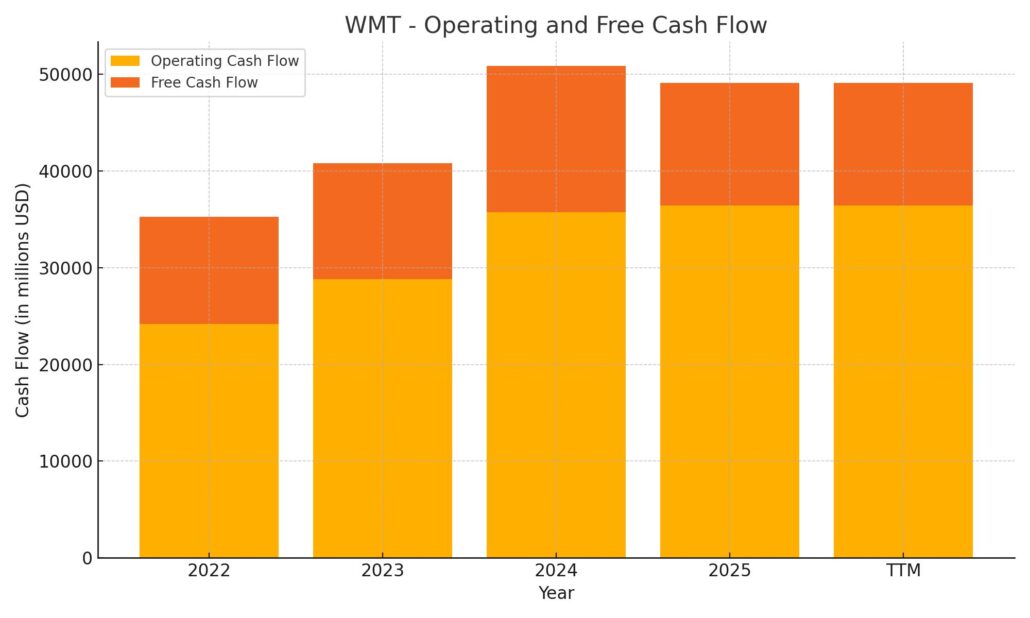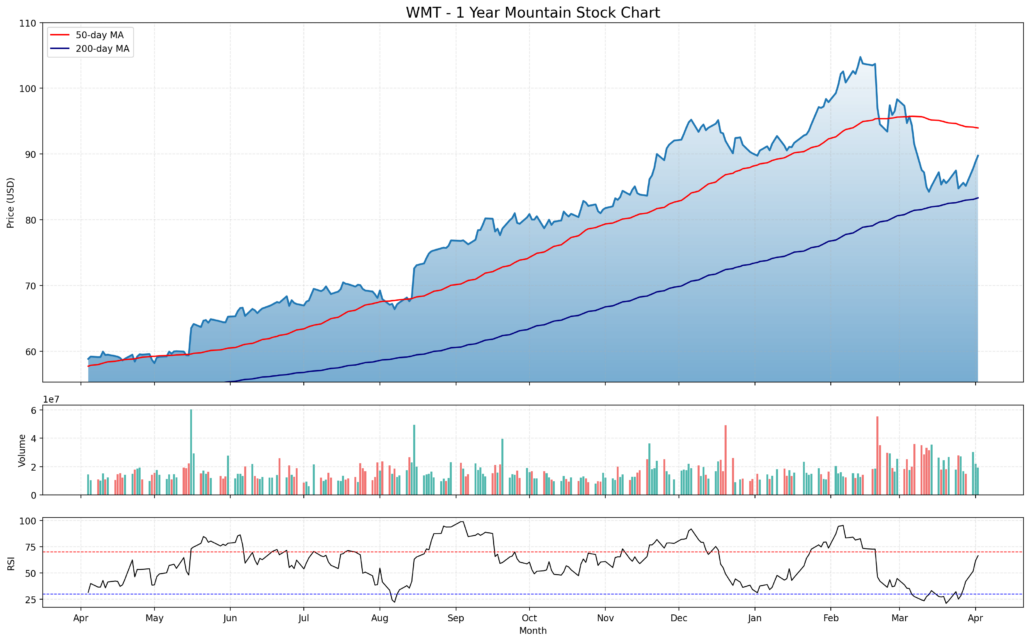Updated April 2025
Walmart’s a familiar name to just about everyone, but for dividend investors, it’s more than just a retail giant—it’s a slow and steady income machine. With a history stretching over half a century of consistent dividend growth, this stock doesn’t try to impress with high yields or dramatic spikes. Instead, it quietly delivers a reliable stream of income, backed by a rock-solid business that’s evolved far beyond its roots.
At its core, Walmart remains one of the most dominant forces in global retail, but it’s been sharpening its tech and logistics game in recent years, pushing harder into e-commerce, digital payments, and supply chain efficiency. For income investors, that means one key thing: staying power. And in the dividend world, that matters more than flash.
Recent Events
Walmart’s latest headline was its 3-for-1 stock split in February 2024. While the move didn’t change the underlying fundamentals, it did make the shares more accessible to a wider group of investors, including many employees through Walmart’s stock purchase plans.
But the story goes deeper. Walmart has been growing its revenue—now hovering around $681 billion over the trailing twelve months—while adapting quickly to changing consumer habits. Pickup, delivery, and digital sales are becoming bigger pieces of the pie, and Walmart’s tech stack is starting to look more like a digital platform than an old-school retailer.
Despite that, quarterly earnings took a small step back, with a 4.4% dip year-over-year. Still, the company’s ability to churn out free cash flow hasn’t wavered. It’s generating over $36 billion in operating cash flow and nearly $8 billion in levered free cash flow. That’s more than enough fuel to keep the dividend humming.
Key Dividend Metrics 🧮
📈 Forward Dividend Yield: 1.05%
💵 Forward Annual Dividend: $0.94
📊 Payout Ratio: 34.44%
📆 Ex-Dividend Date: May 9, 2025
💰 5-Year Average Yield: 1.44%
📉 Trailing Dividend Yield: 0.93%
⚙️ Dividend Growth Streak: 51 consecutive years
🔧 Recent Split: 3-for-1 on Feb 26, 2024
Dividend Overview
Walmart doesn’t wave a big flag with its dividend. It’s not trying to be the highest yielder out there. Instead, it sticks to what it does best—delivering steady, predictable income, year after year. With a forward yield of 1.05%, it’s not going to wow investors chasing big payouts, but that’s not the appeal here.
What really stands out is how comfortably that dividend fits within Walmart’s financials. A payout ratio of just over 34% means the company is keeping a healthy cushion. That kind of restraint is what allows Walmart to keep the dividend going through good years and bad without having to scramble for cash or stretch its balance sheet.
There’s also something to be said for the way Walmart handles its dividend schedule. It already has a payment date locked in for January 2026—a rare level of visibility that reflects how confident management is about its future cash flows.
For income investors, especially those reinvesting dividends, the 3-for-1 split earlier this year may seem like a small detail, but it could actually improve long-term compounding. More shares mean more reinvestment flexibility, particularly in tax-advantaged accounts.
Dividend Growth and Safety
Here’s where Walmart really sets itself apart: consistency. This company has increased its dividend for 51 straight years. That puts it in rare company—Dividend King status. These aren’t big jumps each year, but they are steady. And in dividend investing, consistency beats drama every time.
The growth pace of the dividend has been on the modest side in recent years, which is in line with Walmart’s overall cautious approach to capital returns. But that modesty comes with benefits. It’s given the company the ability to maintain that growth streak without interruption.
Looking at the numbers, safety isn’t in question. The nearly $8 billion in levered free cash flow and the strong operating cash flow figures show there’s plenty of room to support the dividend—even in years when earnings growth stalls. Walmart doesn’t overextend itself, and that’s reflected in the way it balances investment, debt management, and shareholder returns.
Debt is something to be aware of, with over $62 billion on the books, and a current ratio under 1. That could raise eyebrows, but Walmart’s reliable cash flow helps keep the picture stable. The company has no trouble covering its obligations, and its long-term investment-grade credit profile gives even more reassurance.
It’s also worth circling back to the dividend per share post-split. At $0.94, it may look smaller than before, but it’s simply been adjusted for the new share count. The actual income you’re receiving hasn’t changed, just how it’s sliced.
In the end, Walmart is one of those dividend stocks that won’t set off fireworks, but it doesn’t need to. Its appeal lies in strength, resilience, and decades of shareholder commitment. For investors focused on reliability and steady income, this is a name that just keeps delivering, one quarter at a time.
Cash Flow Statement
Walmart’s trailing twelve-month (TTM) cash flow data shows a company with strong operational efficiency. Operating cash flow sits at $36.4 billion, reflecting its ability to consistently generate cash from core business activities. This is a steady climb from $24.2 billion in fiscal 2022, indicating improved working capital management and stable profitability despite some earnings softness. Free cash flow over the same period came in at $12.7 billion, showing Walmart still has solid cash left over after capital expenditures, even as it continues to invest heavily in infrastructure and digital capabilities.

On the investment side, cash outflows totaled $21.4 billion, largely driven by $23.8 billion in capital expenditures. That’s a notable increase over recent years, signaling a clear push toward long-term growth through tech upgrades, fulfillment centers, and store modernization. Financing cash flow remained negative at $14.8 billion, consistent with Walmart’s ongoing shareholder return program—debt repayments and stock buybacks played key roles here. The end cash position of $9.5 billion, while slightly down year over year, remains healthy and sufficient for near-term needs.
Analyst Ratings
📈 Walmart’s stock has recently seen a mix of analyst opinions, reflecting both optimism and caution regarding its future performance. As of now, the consensus among 43 analysts is a “Buy” rating, with an average price target of $108.11. This suggests a potential upside of approximately 21.7% from the current trading price of $88.83.
🔄 Several analysts have adjusted their price targets and ratings for Walmart in recent months. For instance, Stifel Nicolaus lowered their price target to $93 while maintaining a “Hold” rating. This move was influenced by concerns over consumer confidence and how it might weigh on spending patterns, particularly as inflation continues to pressure households.
🛒 On a more upbeat note, Jefferies maintained their “Buy” rating with a price target of $120. The firm pointed to Walmart’s rising appeal among higher-income shoppers and praised its forward-looking investments in technology and e-commerce infrastructure as drivers of future growth.
📊 Evercore ISI also weighed in, tweaking their price target to $100 from a previous $107, though they reaffirmed an “Outperform” rating. Their stance reflects cautious optimism, recognizing Walmart’s strong fundamentals while acknowledging the broader headwinds in the retail landscape.
🧭 Altogether, analyst sentiment shows confidence in Walmart’s long-term direction, especially as it evolves into a more tech-enabled and diversified retail powerhouse.
Earning Report Summary
Walmart’s most recent earnings gave investors plenty to think about. The numbers were solid, but the tone had a hint of caution that’s worth paying attention to.
Steady Growth in the Core Business
The company posted earnings per share of $0.66, which came in just above what most were expecting. Revenue for the quarter landed at $180.6 billion, reflecting a modest gain compared to the same period last year. U.S. comparable sales rose 4.6%, showing that shoppers are still coming through the doors—even if they’re keeping a closer eye on their wallets.
What really stood out, though, was Walmart’s continued momentum in e-commerce. Online sales globally grew 16%, a signal that the company’s digital investments are paying off. It’s not just about groceries and household staples anymore—Walmart is making real headway in expanding its online reach and fulfillment capabilities.
Signals of Confidence with a Touch of Caution
Walmart also reported a 29% jump in advertising revenue, a relatively new but fast-growing part of the business. That kind of growth helps diversify revenue streams, which is a good thing when the retail environment can shift so quickly.
That said, the company’s forward guidance was a bit more measured. Executives projected earnings per share in the range of $2.50 to $2.60 for the upcoming fiscal year, which came in just a touch under Wall Street’s expectations. It’s not a red flag, but it does reflect some uncertainty—whether from inflation, changing consumer behavior, or just a conservative outlook from management.
Still, Walmart isn’t holding back on showing confidence in its long-term strength. The company announced a 13% increase in its annual dividend, its largest boost in over ten years. That’s a strong message to shareholders: despite a complex macro backdrop, the business feels secure enough to return more capital.
All in all, it was a quarter that balanced reassurance with realism. Walmart is doing a lot of things right, especially when it comes to adapting for the future, but it’s also keeping expectations grounded as it moves forward.
Chart Analysis

WMT has had an interesting ride over the past year, and this chart tells the story of a stock that’s seen a strong run, a pullback, and now possibly a turn back up. The price action over this 12-month stretch shows solid long-term momentum, even though it recently cooled off after a steep climb.
Price Movement and Moving Averages
The price climbed steadily from around $58 early last year and pushed past $100 before pulling back. It spent a good chunk of time above both the 50-day (red) and 200-day (blue) moving averages, a sign of strength and trend confirmation. That said, the recent drop in March brought the price down below the 50-day moving average, which has now started to curl slightly lower. Meanwhile, the 200-day continues to slope upward, suggesting that the longer-term trend is still intact despite the short-term pressure.
Now in April, the price is working its way back up. It’s not fully recovered, but the move higher suggests buyers are stepping in again after the dip.
Volume and Buying Interest
Volume has remained fairly stable across the chart, with a few spikes on red bars during some of the selloffs. There hasn’t been a dramatic surge in buying volume yet, but the recovery off the March lows shows that some accumulation may be happening quietly. The lack of a breakdown below key support levels during the pullback is worth noting—it suggests the drop was more of a breather than a breakdown.
Relative Strength Index (RSI)
Looking at the RSI on the lower panel, it dropped to oversold levels around March, then quickly turned upward. It’s currently sitting just under 70, which puts it near the upper end of the neutral range. That bounce off oversold territory lines up well with the recent price recovery and could hint at renewed momentum. If it breaks above 70 again, that would be another technical positive.
Overall, this chart reflects a strong underlying trend that took a healthy pause. The pullback didn’t reverse the broader uptrend, and the current price action looks constructive. If the price can reclaim the 50-day average and hold it, the longer-term trajectory remains positive.
Management Team
Walmart’s leadership group blends long-time insiders with strategic hires from outside the organization, creating a team that balances tradition with innovation. Doug McMillon, the company’s President and CEO, started as an hourly associate back in the 1980s. His long tenure and experience across multiple areas of the business give him a clear, hands-on view of how Walmart runs and what it needs to move forward.
John David Rainey, the Executive Vice President and Chief Financial Officer, plays a key role in managing the company’s financial strategy. With a background that includes previous stints at other large public companies, Rainey brings a thoughtful, investor-focused approach to Walmart’s balance sheet and long-term planning. His guidance is particularly valuable as the company continues to invest heavily in tech and infrastructure while returning capital to shareholders.
Suresh Kumar, Executive Vice President and Chief Technology Officer, is a central figure in Walmart’s shift toward a more digitally focused future. His leadership on the technology side is helping the company modernize its operations, improve supply chain logistics, and expand its e-commerce reach. This combination of retail knowledge and innovation-minded thinking has allowed the management team to steer Walmart through a period of rapid change with a steady hand.
Valuation and Stock Performance
WMT is currently trading around $89.76, reflecting a cooling off from recent highs just above $100. That pullback has brought the stock closer to its 200-day moving average, which may offer a more attractive entry point for some long-term investors. The price-to-earnings ratio is sitting at about 42, which is a bit elevated compared to historical norms. However, this isn’t entirely surprising given Walmart’s consistent performance and the market’s willingness to pay a premium for companies with stable cash flow and strong balance sheets.
The forward P/E sits closer to 34, hinting at expectations for earnings to catch up to the stock price in the near future. Walmart’s valuation may not scream “cheap,” but when viewed through the lens of long-term consistency, it’s not wildly expensive either. Price-to-sales and enterprise value to EBITDA metrics also point to a company priced above average, but not in a range that would suggest speculation or irrational exuberance.
Over the past year, WMT has delivered a return of over 50%, easily outpacing the broader market. That performance was fueled in part by strong execution, increased dividend payout, and optimism about Walmart’s positioning in both traditional and digital retail. While the recent pullback has cooled momentum, the underlying trend remains solid.
Risks and Considerations
Even a company as steady as Walmart isn’t without its challenges. One of the main concerns going forward is margin pressure. As the company leans into lower-margin business lines like grocery and continues investing in e-commerce infrastructure, there’s a natural drag on overall profitability. E-commerce is growing, but the shift to digital also brings fierce competition and logistical complexity.
Inflation is another factor to keep an eye on. While Walmart often benefits from economic stress—drawing in shoppers looking for value—persistent inflation could compress margins further and change consumer behavior in unpredictable ways. Any squeeze on purchasing power might also affect discretionary sales, even for a low-price leader like Walmart.
Debt levels are another area worth watching. The company carries over $60 billion in total debt. While this hasn’t become a major issue thanks to strong cash flow, it does limit flexibility if interest rates remain elevated or if macroeconomic conditions turn unexpectedly.
There’s also the competitive landscape. Amazon remains a powerful rival, especially online, and the cost of keeping up with next-day shipping, inventory tech, and same-day pickup is substantial. At the same time, Walmart has to continue adapting to regulatory pressures and wage inflation, especially given its massive workforce.
Lastly, the valuation itself introduces some risk. While Walmart isn’t priced for perfection, it also isn’t cheap. If earnings growth slows or hits a rough patch, the stock could be vulnerable to a reset, especially in a market that’s becoming more selective.
Final Thoughts
Walmart doesn’t need a flashy story to make its case. It’s a business that simply delivers—year after year, quarter after quarter. From the steady hand of its leadership team to the disciplined approach to capital allocation and the quiet consistency of its dividend, the company offers a level of dependability that’s tough to find.
The stock has pulled back from recent highs, but the underlying business hasn’t skipped a beat. If anything, the recent dip may just be a reflection of broader market jitters rather than anything company-specific. The e-commerce gains, strategic investments, and growth in advertising all speak to a company that’s still adapting and evolving—without losing sight of what it does best.
Walmart may not make headlines every week, but its ability to balance scale, technology, and customer loyalty continues to keep it relevant in a fast-changing retail world. It’s not chasing hype. It’s building quietly, methodically, and effectively. That kind of strategy doesn’t always get the spotlight, but over time, it’s what tends to work.

